FIELD VETERINARY REPORT FOR SOUTHERN CONSERVATION AREA MOBILE VETERINARY UNIT FOR THE MONTH OF OCTOBER 2016 Reported by Ndambiri Ephantus Introduction North West of Mt
FIELD VETERINARY REPORT FOR SOUTHERN CONSERVATION AREA MOBILE VETERINARY UNIT FOR THE MONTH OF OCTOBER 2016
Reported by Ndambiri Ephantus
Introduction
North West of Mt. Kilimanjaro on the border with Tanzania lies Amboseli National Park. A large concentration of wildlife lives here in the dry season making Amboseli a popular tourist destination. Among the wildlife habitats in the National Park are open plains, acacia woodland, rocky thorn bush country, swamp and marshland together with a temporary lake. This vegetation is what gives animals reprieve especially during the dry season.
There has been relatively few human-wildlife incidences reported this month though the team did treat one elephant with an arrow wound, a snared of lion and a snared giraffe.
The following are veterinary activities within the conservation area during the month:
Surveillance at Namerok Springs
During the rainy season the spring drains all the way to Amboseli National Park about 20km away. The spring is largely used for horticulture irrigation on a small scale by the farmers within the locality growing vegetables for own subsistence and local sales. Water is directed to the farms by use of fallows/channels some with concrete lining and others without resulting to wastage. However during the dry season the water is seemingly not enough for community domestic use.
These irrigated farms lie within the corridor between Kimana Sanctuary and Amboseli National Park. This encroachment has persistently been the result of human –wildlife conflict as animals especially elephants raid farm crops on their either way. Traces of fences are still evident with presence of standing posts but with no wires. It is believed that if the fences were maintained properly such occurrences could be non-existent.
The source of the spring is protected by a brick wall perimeter which is poorly maintained as it has a gap through which cattle access the source and degrade its condition as they drink and graze. An important solution ought to be the construction of water troughs outside the spring source perimeter wall for animals to drink from, and maintenance of crop farm fences to avert human-wildlife conflict.


Surveillance within Amboseli National Park
Throughout the month the Amboseli Unit did a lot of surveillance within and around Amboseli National Park. The team visited the famous Tim who was in the company of 10 males all of which were in good health. Meshanani Gate is the furthest point of park entry from the Park Headquarters. The area is far away from Enkongo swamps and other permanent swamps making it relatively dry compared to areas near the swamps. The team visited the area and found it to be very dry due to the poor rainy season. There were few wild and domestic animals browsing and grazing on drying plants.
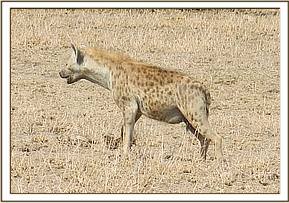

The team also visited Lake Amboseli which has been dry for much of the year. It floods during years of heavy rainfall. Tracks of wild animals and their droppings is evidence that animals traverse through the Pleistocene lake basin. Others are unfortunate and die along these trucks and the team found carcasses that had been eaten by predators, making determination of cause of death impossible.
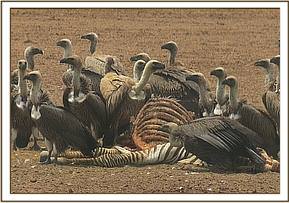
The swamps and plains are still green enough to provide food and water for many herbivores including many hippos, buffalos, elephant and other grazers.
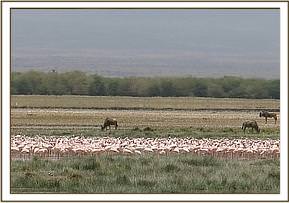
CASE # 1: Treatment of an injured elephant
Date: 5th October 2016
Species: Elephant
Sex: Male
Age: Sub adult
Location:Umani spring area; Chyulu
History
The elephant was initially spotted by Umani Rangers on 28th September this year within the thick Kibwezi forest, only to disappear before veterinary assistance was offered. It resurfaced near Umani springs still severely lame as spotted and reported by same the rangers. Quick intervention was sought by air lifting the from Amboseli National Park using DSWT light aircraft to the Chyulus where DSWT helicopter was waiting in order to facilitate easy fast and effective darting.He was found under the tree canopy resting, under keen watch of three Umani rangers.
Immobilization, examination and treatment
Narcosis was effected by use of 14mgs Etorphine in 3cc dart filled with 1000I.U Hyalase. The elephant was forced to move out of the thick shrubs by the helicopter from which darting was done. It was darted as he closed the dusty road. He was maintained on visual at the edge of the dusty road and was down on right lateral recumbence in six minutes. Straps tied around the front limbs and anchored on to tractor were used to flip him over to left lateral recumbence. The right ear was used as blind fold and trunk was kept patent with aid of a piece of stick at the end.
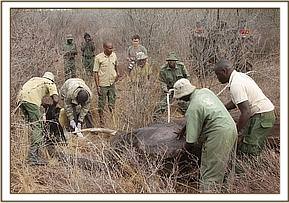

He was slightly emaciated and severely lame on the right fore limb. At the lateral right humerus bony prominence was a half centimeter diameter penetrating creamy pus oozing wound. It was pronged but was shallow only holding about 20cc fluid by volume. At the same limb fetlock joint area laterally was a shallow septic maggot infested wound about10cms in diameter. At the left ear at lower third margin distally was another shallow pus covered wound about 12cms diameter on the inner side. The shallow wounds could have caused by blunt trauma accrued probably as animal wander on rugged bushy lava terrain while the penetrating one appeared to have been caused by an arrow.
The tree wounds were attended to one after the other all receiving similar attention. Each was cleaned with copious amount of Hydrogen Peroxide allowing enough effervescence to remove as much dead tissue as possible. Then each was flushed with Tincture of Iodine adlibitumly. The penetrating wound was slightly deep just accommodating about 20cc of fluid by volume but just on humerus lateral prominence. The two shallow wounds were generously topically covered by 20mgs ivermectin to get rid of maggots where possible while the shoulder one was infiltrated with one tube of Cloxacillin cream. All were then smeared with wet green clay to enhance epithelialization.
Systemically it was injected with 30000mgs Tetracycline and 50mgs Flunixin Meglumine into different muscle sites. The right eye was infiltrated with one tube of Cloxacillin cream and so was dart wound on the longismus muscle.
Reversal
Revival from narcosis was done using 24mgs Diprenorphine into jugular vein administered shortly after 80mgs Naltrexone intramuscular. The animal got up energetically after three minutes and limped cautiously away.
Prognosis
This is fair to guarded considering that the arrow used could have been raced with poison. Sepsis could have extended to joint tissue by the time treatment was conducted.
CASE # 2: Desnaring of a lion
Date: 10th October 2016
Species: Lion
Sex: Male
Age: Sub adult
Location: Community area outside Ndera Conservancy in Tana Delta
History
It was spotted and reported by community members and confirmed by Northern Rangeland Trust rangers in Issak Bin Conservancy on the 9th October. The vet was flown there by the DWST light aircraft from Karuku, picked by the conservancy ground team and taken to where the lion was snared (tethered) in the community area using winch wire.
Immobilization, examination and treatment
It was sedated using 150mgs Ketamine and 1.5mg Medetomidine in 1.5cc dart. Darting was completed on foot because it was in a thicketed area where vehicles could not access. It was fully sedated in four minutes and blindfolded using a towel. It was placed on right lateral recumbence to assess the snare damage.
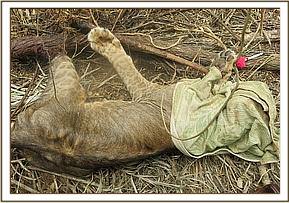
A foul smell was emanating from the snared left hind limb wound. It was observed that the winch snare was anchored onto a tree branch resulting to tether-like action on the snared lion. Snare wire was just below the hock joint from where the lion had self-mutilated the rest of the limb as it tried to remove the snare. Exposed metatarsus joint bone components were evident of the trauma suffered giving an indication of an amputated limb. The wounds were heavily infested with maggots meaning the animal had been trapped for more than a week without food or water. This was also depicted by emaciation and dehydration of the animal.


Prognosis
Due to poor prognosis the animal was euthanized using 2000mgs Sodium Pentobarbital intracardial to eliminate suffering. Trophies were secured by the KWS Garsen Post of Tana Delta Station for safe custody and onward transmission.
CASE # 3: Treatment of an injured elephant calf
Date: 10th October 2016
Species: Elephant
Sex: Male
Age: Calf
Location: Tsavo East National Park
History
The elephant was spotted and reported by DSWT Tsavo East desnaring team as having difficulties in walking caused by a swelling on the left hind limb knee joint. The Amboseli Vet Unit was within the Tsavo East having responded to another case concerning a snared lion in Tana Delta. The Vet was flown from Tana Delta to Voi airstrip by DSWT aircraft to connect with DSWT ground teams.
Immobilization, examination and treatment
It was darted with 1.5mgs Etorphine in 1.5cc dart filled with 500I.U Hyalase. Vehicle darting was used and the elephant was within a family of ten individuals. The dart landed on the right gluteal muscle; he was slowly limping on the left hind limb. The aim was to immediately chase the other family members to a safe distance immediately after the calf went down following narcosis. It was fully immobilized in five minutes assuming right lateral recumbence.Promptly thefamily members were chased away using one vehicle as the other vehicle remained to safeguard the vet team. The left ear was used as blind fold and trunk was kept patent with aid of a piece of stick across distal open end.
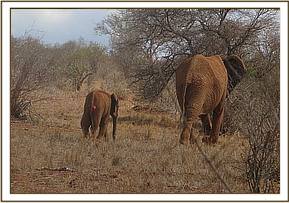

The left hind limb had several traumatic wound injuries at the knee joint laterally making the limb swollen. The four penetrating wounds were assumed to have been caused by attempted lion attack on the calf. All were probed using forceps and only one was slightly penetrating into muscles yielding approximately 50cc tenacious creamy pus. Others were superficial just like the other one which was on the left flank area just above the knee. They were about three to four days old and had no maggot infestation. He was bearing weight on the limb hence fracture was ruled out.
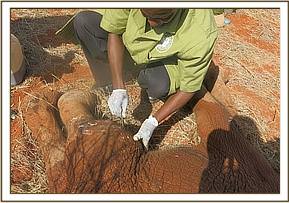

All were cleaned with Hydrogen peroxide and rinsed with Tincture of iodine expressing all dead debris and pus. Three Cloxacillin antibacterial cream was infiltrated in all wounds before wetted Green Clay was generously packed in each. Systemically it was injected with 20cc each of Multivitamin, Colvasone and Amoxicillin in different syringes and needles at different muscle site. The dart wound was infiltrated with one Cloxacillin cream tube to avoid abscess development.
Reversal
Anesthesia was reversed using 12mgs Diprenorphine Hydrochloride into jugular vein prompting it to be up in three minutes.
Re-union
He called out (trumpeted) to the family members who were about hundred meters away. One vehicle was left near the calf while the other went to drive the rest of the family members towards the calf. His mother was also trumpeting and when they were thirty meters apart the vehicle guarding the calf pulled away. The mother spotted the baby and went straight to it followed by the rest of family members. All recognized the calf and ambulated away slowly towards the waterhole nearby. It will be reviewed in one week time and intervention performed accordingly if need be.

Prognosis
Was presumed to have fair prognosis considering the wounds were less than a week old and calf was still strong.
CASE # 4: Desnaring of a giraffe
Date: 12th October 2016
Species: Maasai Giraffe
Sex: Male
Age: Adult
Location: Oloirero Borehole-Serengei Conservancy
History
The giraffe was reported by Big Life scouts as having been snared on the right hind limb. The Amboseli Unit responded promptly and met Serengei Conservancy led by the warden on the ground.
Immobilization, examination and treatment
Immobilization was initiated by a cocktail of 13mgs Etorphine and 70mgs Azaperone. Vehicle darting was used and at speed because the giraffe was very apprehensive. The terrain was comprised of thorny shrub and was a challenge as he kept hiding behind them in attempt to avoid clear darting path. First dart was faulty as it never discharged and quickly another was prepared and darted. The dart was successful and the animal went down. Ambient temperature was very high and the animal had run for some time thus the exercise was aimed to be achieved very quickly to avoid any complication in the treatment thereof. It wasblindfolded using towel and pinned on the ground by the neck and head on left lateral recumbence. Water was generously dowsed on the body.
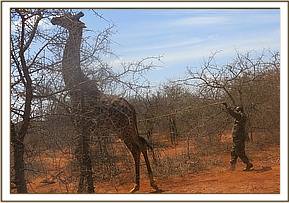

The winch snare wire snoop was around the distal metatarsal area of the right hind limb barely tight and there was no resultant traumatic wound. It was about five meters long and was brushing against obstacles (bushes) as the animal ambulated, acting as a nuisance. The snare was quickly loosened and taken off the limb distally. The animal was covered with 50mgs Dexamethasone intramuscularly to stabilize cell membranes because of the running before and after darting.
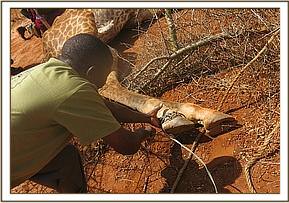

Reversal
He was reversed using 160mgs Naltrexone injected into jugular vein barely four minutes after he was roped down. He was up energetically in two minutes and ran away into the thorny shrub.
Prognosis
It had a favorable prognosis as the snare had not caused any traumatic wound.
ACKNOWLEDGEMENT
We thank the KWS-DSWT partnership through which ailing animals have been able to receive a second chance at life with timely and professional veterinary intervention. Proactive field surveillances have been completed with the aim of perceiving any potential cause for concern and putting measures in place in order to avert such instances. All these have been enabled due to sponsorship through donors to the David Sheldrick Wildlife Trust.






















